During a recent consulting engagement, I was asked by an inquisitive team member on what “value” would a design thinking methodology (abbreviated to ‘DT’) deliver to a business, and also, which “DT process” from a long list would be more suitable for a software development project. The value that is delivered from a collaborative design effort is well documented and could be easily articulated, however, in the case of design processes there are several DT frameworks for reference which would leave anyone to grope for answers, and this encouraged me to compile some knowledgeable DT frameworks into an article. On the onset, the objective behind compiling these frameworks into a single post wasn’t about verifying the efficacy of the frameworks, it was about grasping the ethos behind the design process and to comprehend how various forms of co-creation exercises are conducted. This isn’t an exhaustive list of DT frameworks but just some of the more well-known ones that I have come across regularly during my research.
To ‘Design’ Is ‘Design Thinking’
Industry analysts have widely supported the adage “Good design is good business” meaning that design must be at the core of an organization’s innovation strategy, and indeed, there are myriad design frameworks which outline a collaborative thinking process towards arriving at that objective. Also, just as the numerous frameworks there is a corresponding list of definitions for design thinking, such as, Idea Couture’s Global CEO and co-founder Idris Mootee who terms ‘design thinking’ as a “new management wonder drug” which companies look upon hopefully to save them from the uncertainties and failures of traditional management styles. My personal favourite remains a quote from IDEO’s CEO Tim Brown, which is all-inclusive and repeatedly mentioned during presentations and workshops:
Design thinking is a human-centred approach to innovation that draws from the designer’s toolkit to integrate the needs of people, the possibilities of technology, and the requirements for business success.
Many in the industry have relegated ‘design thinking’ to merely a jargon or a figment of business school terminology, though it would be quite naive on their part to ignore the peaking interest amongst a global audience in the subject over the last 5 years.
With its varied forms and definitions, it’s not surprising that Design has remained an enigma for many. At its very least, a design could be construed as a process associated with ‘aestheticism’ but in terms of strategic thinking, it could bring together vast amounts of resources — finance, manpower, ideas, or even tech sources, to achieve an optimum target. Particularly since it almost never aspires to follow a linear set of actions and tools design remains focussed on finding answers to ‘How’ something could be accomplished not ‘What’ is to be accomplished, this basic presumption immediately broadens the horizon and enables to capture divergent opinions for an outcome.
Finally, this selection of design thinking frameworks reflects upon the underlying ideology of its respective organization, those which are striving to achieve a common vision for their customers. Their benefits as a model for co-creation exercise is therefore undisputed.
IDEO
In 2009, IDEO’s Tim Brown published what I call a ‘comprehensive textbook’ titled Change By Design on the impact of human-centric design on industrialization and social innovation, in which, he provides his framework based upon the principles of Viability (business), Desirability (human), and Feasibility (technical). IDEO’s model has always been considered as a traditional design thinking process.
Thinking like a designer can transform the way organizations develop products, services, processes, and strategy. This approach, which IDEO calls design thinking, brings together what is desirable from a human point of view with what is technologically feasible and economically viable. It also allows people who aren’t trained as designers to use creative tools to address a vast range of challenges.
IDEO is amongst a handful of companies which consider ‘design’ to be a human process outlined by an active collaboration and observation of people, in that, it takes an integrated approach to design thinking as a process which has a system of overlapping spaces instead of an orderly sequence of activities dividing the framework into 3 spaces: inspiration, ideation, and implementation.
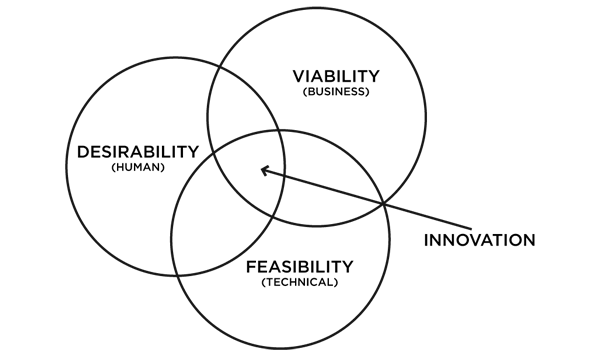
In their article titled Design Thinking for Social Innovation on the impact of design thinking on the social sector, Tim Brown & Jocelyn Wyatt provide a detailed description of IDEO’s three-pronged approach that includes inspiration, ideation, and implementation. In the inspiration phase, designers distil their ideas into insights from on-field observations and design research conducted on human behaviours which would lead to tangible solutions. In the ideation phase, a diverse group of multidisciplinary people get involved to create experiences and test contending ideas against the insights which have been drawn from the inspiration phase. Ideally, an interdisciplinary group would involve “’T’-shaped” individuals who possess a depth of specific skill set in their fields – MBA, engineers, architects, and so on on the vertical axis, and at the same time, play the role of a design thinker on the top axis by empathizing with a broad set of a divergent population. Finally, in the implementation phase, the ideas which generated favourable concepts would be transformed into viable prototypes, in other words, turning ideas into actual products and services which can be tested with users, iterated and refined further. The prototyping process seeks to uncover unforeseen implementation challenges and consequences. This clear-sighted methodology of DT by IDEO has been widely popular and promoted by many in the industry.
Think of inspiration as the problem or opportunity that motivates the search for solutions; ideation as the process of generating, developing, and testing ideas; and implementation as the path that leads from the project stage into people’s lives.
IDEO has also created the Human-Centered Design Toolkit or HCD Toolkit and a comprehensive framework on how DT could impact the social sector called The Field Guide to Human-Centered Design. If you’re interested, IDEO.org’s DesignKit website provides a great resource for learning on IDEO’s DT activities and phases for design co-creation.
Stanford d.school / The Hasso Plattner Institute of Design
The Hasso Plattner Institute of Design at Stanford is more commonly known as the ‘Stanford d.school’ and was founded by David Kelley IDEO’s co-founder and an electrical engineering professor at Stanford, along with other professors in 2004. It’s a one-of-a-kind design school that does not award any degrees for graduating from the program. In fact, it was Steve Jobs who talked David Kelley out of handing out degrees because he thought degrees are “flaky”. The d.school offers programs with the aim to bring together students from across Stanford University and business leaders from the industry into exploring their creative confidence and its DT framework has a 5-level journey.
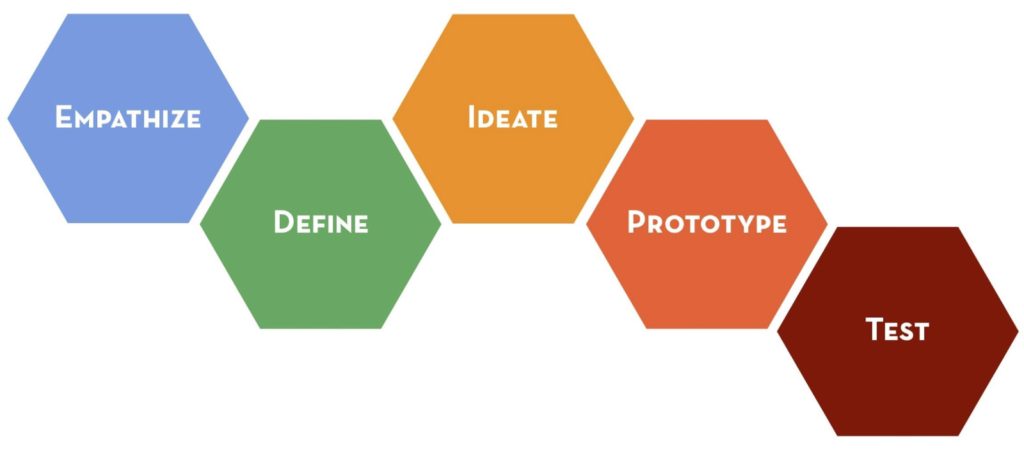
- Empathize – in this phase, a team of individuals would conduct observation and interview exercises to empathize with the behaviour in order to discover unmet user needs.
- Define – after gaining a fair amount of empathy from observing/interviewing users, teams are encouraged to capture stories of the actual tasks which would contain the user description, the need and an insight which you may have gathered in the first phase.
- Ideate – this is the phase where the actual brainstorming of solutions begins in earnest. You reframe the problem based on the previous two phases and brainstorm on the possibilities and go as wide as you could (divergent thinking). There are rules to using positive expressions in encouraging more ideas.
- Prototype – prototyping is about creating a minimum viable product (MVP) and to capture the basics of experience, interactions, etc. This is the stage to produce a tangible solution that would address the customer’s needs.
- Test – and finally, it’s time to test that prototype with the customers and get early feedback on the interaction and the experience, this is part of the ‘fail fast fail often’ strategy in building user-centric products.
For more information on the process and the exercise templates for each of the 5 stages, you could refer to this post on Medium.
Idea Couture
Through some patient researching, I was able to get some insight into Idea Couture’s (IC) DT framework, a strategic design consulting firm, which draws an integrated approach. Unlike other frameworks that I have studied, combines DT with futures thinking and applies that wholesome methodology as a means to achieve a business strategy for customer experience innovation. In that context alone, IC has come up with a game called ‘IMPACT – A Foresight Game‘ for learning the basics of strategic foresight1 thinking. Idea Couture’s DT framework is largely derived from market research and analysis, using storytelling & observational research to articulate unmet customer needs, and then processing that data into visuals through rapid prototyping in visualizing tangible versions of the future. IC has branded its distinct framework as “D-School + B-School”, in other words, a strategy which integrates the multidisciplinary capabilities of design schools (D-School) with the strategic & analytical thinking of business schools (B-School), in deriving a humanistic approach for creating business value for its customers. To sum things up, Idea Couture’s DT framework combines the fields of System Thinking, Business Strategy and Design, while also blending Futures Thinking to make sense of tomorrow’s market for customer experience. Idea Couture was acquired by Cognizant in 2016.
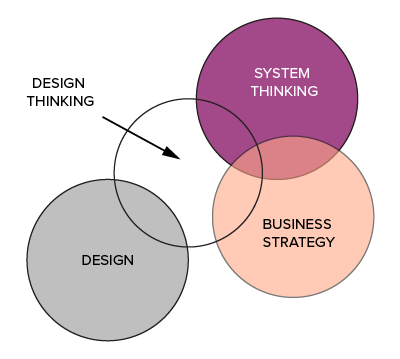
1 Strategic foresight is a process of establishing well-informed and future-oriented perspectives that help fuel, guide, and inspire innovation, strategic planning, and critical decision-making. Applied to product innovation, service design, or organizational transformation, foresight helps organizations better anticipate change by equipping them with the tools and resources needed to ask provocative questions, challenge dominant logics, test assumptions, rethink opportunities, and reset goals. – Idea Couture
Frog Design
Frog has an interesting DT methodology which is fluid and allows exploration of ideas in a non-linear fashion. It’s been dubbed the ‘Collective Action Toolkit’ or shortened as CAT and its goal, like other DT frameworks, is to bring diverse groups of people together to accomplish a shared vision but what makes the CAT methodology unique is its assumption that teams might start with a shared vision but the goals would change each time they learn and grow from an activity. Hence, the participants will continue to revisit the ‘Clarify’ portion lying at the centre of the CAT model which allows time for the team to reflect on the shared vision and insights. From my understanding of CAT’s non-linear strategy, where each phase ends with a confirmation on what was learned and how the new goals align with the overarching vision of the project, it’d be interesting to apply the CAT framework to an actual software development process that mirrors an Agile framework. The framework is outlined in 6 steps: Clarify (Your Goal), Build (Your Group), Seek (New Understanding), Imagine (More Ideas), Make (Something Real) and Plan (For Action).
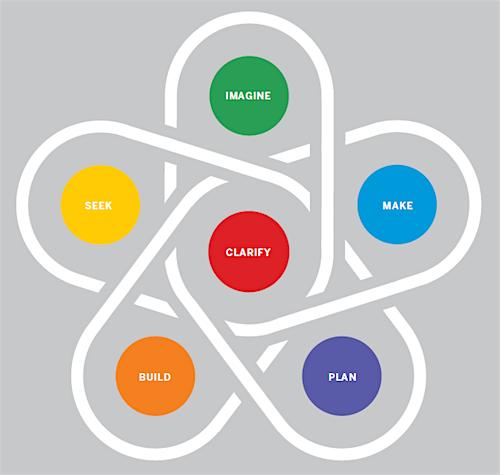
The Collective Action Toolkit (CAT) uses an action map with activities arranged into six areas. All you need is motivation and enthusiasm to get started. From here, you can use the action map to focus your path and help you balance the time needed to both act and reflect. You can work alone or with a group, and there is no wrong place to start. Every activity will help you learn something.
Darden Graduate School of Business – University of Virginia
American strategist Jeanne Liedtka has authored several books on DT, in particular, one of my favourites called ‘Solving Problems with Design Thinking: Ten Stories of What Works’ through which she provides 10 case studies of companies which have successfully transformed their product development and sales using design thinking by producing innovative solutions. In that book, Jeanne advocates a four-staged DT framework, a toolkit for enabling design managers to think like designers in establishing empathy with their customers2. Subsequently, she also introduced this framework in a business innovation course on Coursera, again, as a toolkit for designing for growth for managers. This framework is divided into 4 categories — What Is?, What if?, What Wows?, and What Works? as illustrated below.
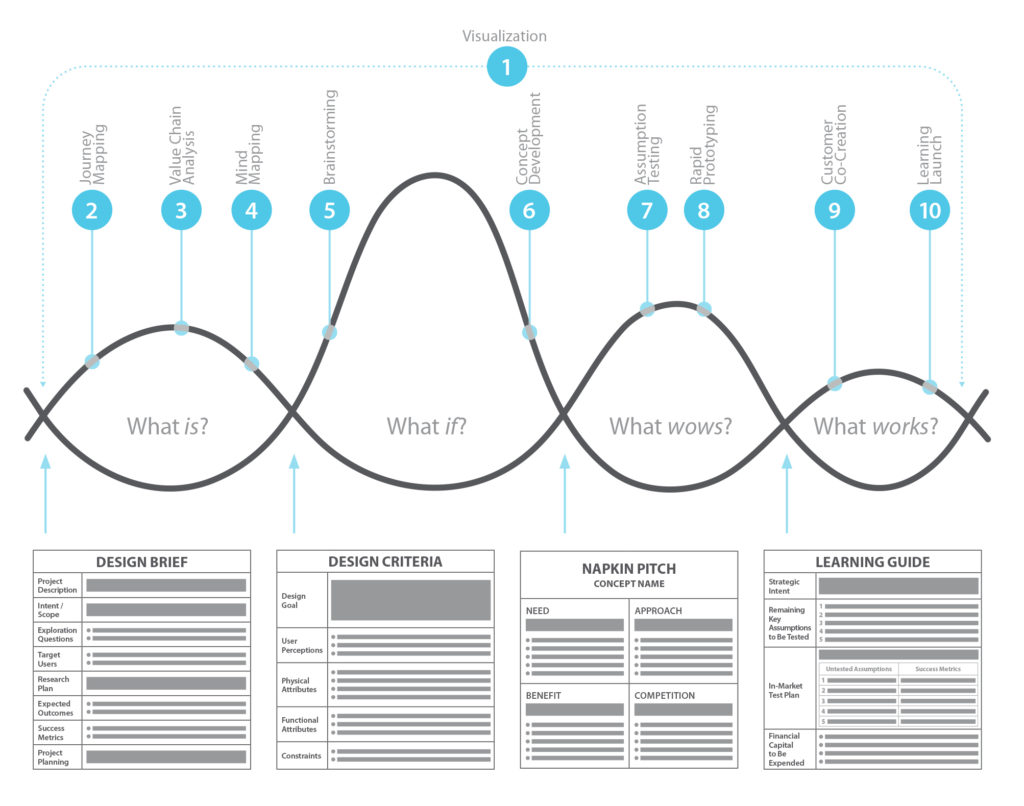
- What is? – The first phase is about taking a deep dive into understanding what’s going on today. The dissatisfaction that customer’s face today is a good starting point to help create a better future.
- What if? – Having developed an understanding of the present situation the ‘what if’ question raises the possibility of generating numerous creative ideas which satisfy the needs of the customer’s pain points. The second stage activities undertake a series of ideas which are captured in what’s termed as a “napkin pitch”, basically, a simple description that could fit on a paper napkin.
- What Wows? – In the third stage, the napkin pitches which were created in the previous phase are tested using rapid prototyping models. Through the prototypes, we test our assumptions to meet customer needs as well as our ability as an organization to execute it, and with it, also test the viability of a business model that brings us profitability through building a sustainable business.
- What Works? – And finally, the fourth question of “What works?” deals with moving forward with the ideas that have made it successfully through the previous three stages and launching them into the marketplace for small-scale experiments with real, live customers that would give us some quick feedback which we can use to iterate and improve our solutions.
Correspondingly, managers are encouraged to use 10 design tools during the process of exploring the creative opportunities and innovation, which are — Visualization, Journey Mapping, Value Chain Analysis, Mind Mapping, Rapid Concept Development, Assumption Testing, Rapid Prototyping, Customer Co-Creation, Learning Launches, and Storytelling. You can get detailed information on using the tools in this article.
2 Finally, design insists that we prepare ourselves to iterate our way to a solution, so managers who thought like designers would view themselves as learners. Most managers are taught a linear problem-solving methodology: define the problem, identify various solutions, analyze each, and choose the best one. Designers aren’t nearly so impatient – or optimistic; they understand that successful invention takes experimentation and that empathy is hard won. The task, first and foremost, is always one of learning.
– from ‘Designing for Growth: A Tool Kit For Managers’ by Jeanne Liedtka and Tim Ogilvie
Closing Remarks
There’s an insightful pattern visible in the design frameworks throughout this compilation, for instance, both IDEO and Frog have a methodology that is inclined in gaining insights for social innovation. Subsequently, Stanford’s d.school has a more linear framework which could be easily comprehensible by beginners and experts alike. Eventually, the ultimate goal of these frameworks is to get a diverse group of individuals together in a co-creation effort for realizing a common vision through empathy & learning. The DT frameworks which I outlined here only signifies the journey and the phases through a process in a design lifecycle, but each phase might use a combination of tools in order to synthesize the ideas required to move to the next level. For instance, the activity of ‘Ethnographic Research’ might use a combination of tools such as ‘user interviews’, ‘data analysis’, ‘contextual inquiry’, or employ them individually. I am hoping this article might have provided a foundational approach towards implementing a design thinking framework for your projects.

